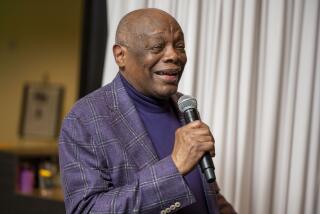Bringing a visionary to life
OK, I plead guilty. I’m a sucker for historical dates and have a weakness for granddaughters.
It was 45 years ago Tuesday that Pat Brown was sent packing out of the California governor’s office. The evictor was a political novice, actor Ronald Reagan.
Nov. 8, 1966 — a time of political turmoil that would have made today’s Occupy bands look like Sunday picnickers in the park. It was an era ripe for political outsiders; rotten for old pols like Brown.
I have an indelible memory of the day after. I was a twerp political writer for a Republican-leaning newspaper, the late Sacramento Union. Despite that, the just-defeated Democratic governor graciously offered me a ride back to Sacramento from Los Angeles aboard his fancy state turboprop, the Grizzly II.
The mood aboard was naturally solemn. I was the only reporter. In fact, there were only maybe five people aboard the large plane, including Brown’s wife, Bernice.
The couple sat quietly together up front, mostly looking out the window of the low-and-slow flying craft at purple-colored harvested fields. I could only imagine Pat Brown’s thoughts. Mine were that I’d missed the college football season — but had covered one heck of a historic political race.
As it turned out, the election marked a dividing line in California politics that later extended nationally — a demarcation between public trust in government and respect for political leaders, and a highly skeptical and fiscally conservative electorate that still exists.
It was a line created largely by the Vietnam War and Watergate — and Reagan’s repeated cry that “government is not the solution, government is the problem.”
On that post-election day at the old Sacramento airport, Brown walked down the stairway to half a dozen reporters and a TV camera. After two terms, he observed, “people were tired of me.”
But what a ride it had been!
Now, two of Pat Brown’s granddaughters have created a documentary film about the visionary builder who died in 1996 at 90.
Yes, it’s sort of what you would expect from two worshiping granddaughters. It’s very complimentary. But it also accurately reflects today’s virtually unanimous view of Pat Brown: He was a great governor.
If any prominent Republican has had a harsh word about the Democrat in the last 30 years or so, I haven’t heard it.
Former Republican Assemblyman Bill Bagley of San Rafael once told me: “At the risk of insulting every other governor I know, from the standpoint of planning for growth in this state, he was the best governor of the 20th century.
“We used to accuse him of being a profligate spender. But we’re living today off his capital investment.”
Tote it all up: three new University of California campuses, six in the state university system, 1,000 miles of freeways and a world-class water project that includes 23 dams and a 444-mile aqueduct.
Those are just inanimate figures.
What’s especially compelling and valuable about the 90-minute film is that it brings Brown to life through the constant use of archival TV footage. You’d probably have to be at least 55 and a California native to have any personal recollection of this historic figure.
But on film you can hear the clear baritone voice, watch the energetic movements, peer into the intense eyes and listen to the belly laugh.
The belly laugh was part of the Pat Brown personality that distinguished him so much from his more aloof son, Gov. Jerry Brown.
“My grandfather was a people person; Jerry’s more of an intellectual,” says Hilary Armstrong, 46, of San Francisco, who produced the film.
The co-writer and director was her sister, Los Angeles filmmaker Sascha Rice, 41. They’re the daughters of Kathleen Brown, former state treasurer, 1994 losing gubernatorial candidate and sister of Jerry.
“I’d be in the car with my grandfather,” Rice says, “and he would roll down the window at a bus stop and start talking to people. ‘How’s it going? How’s your day?’ He was always curious about how people were getting along.”
Watching the film, you get a glimpse of Brown’s skills and tenacity, the qualities that made him a leader.
“It is time to start moving dirt and stop throwing mud,” Brown shouts while campaigning successfully in 1960 for the $1.75-billion bond issue that financed the water project.
It took all the governor’s moxie and muscle to persuade the Legislature to pass the water bill in 1959. What this film does not reveal — nor has anyone ever written that I know of — is what backroom deals Brown cut to win passage.
“We were nervous about what we might uncover,” Armstrong says, especially when they drove to Palm Springs to interview Reagan’s campaign strategist, Stu Spencer. “We thought Stu Spencer might have the dirt.
“But the first thing Spencer said to us was that whenever someone turns on a water faucet in California, they should thank Pat Brown.”
Pat Brown probably took any dirt to his grave.
There’s an oft-repeated theme that the era, not the man, produced Brown’s achievements. California still was in a postwar boom. Environmental protection wasn’t on the radar. The population was half the current size. Land was cheap.
Nonsense. To get anything done in government — then or today — requires a leader. Pat Brown filled the bill.
The film — “California State of Mind, The Legacy of Pat Brown” — has been screened at a few film festivals. It isn’t available for purchase yet, but is expected to be after being shown on PBS stations next year.
For a California political junkie, it’s four stars.
More to Read
Start your day right
Sign up for Essential California for news, features and recommendations from the L.A. Times and beyond in your inbox six days a week.
You may occasionally receive promotional content from the Los Angeles Times.







